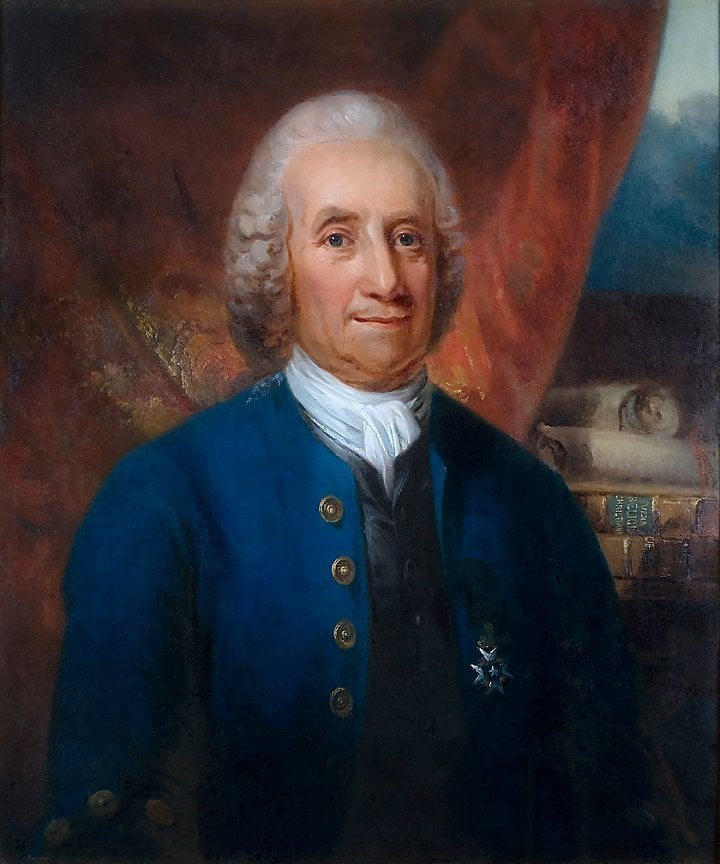
The 18th century Swedish scientist, traveller, statesman, and religious philosopher Emanuel Swedenborg is one of the most fascinating and least understood figures in western history. If people know of Swedenborg at all, it is usually because of his connection with the poet William Blake, who was a follower of Swedenborg but later took argument with him. Or they may know of Swedenborg because of his remarkable psychic powers. Not only did Swedenborg accurately predict the time and day of his death -- March 29, 1772 -- he also somehow knew of a fire that had broken out in Stockholm when he was at a dinner party in another town, some three hundred miles away. Swedenborg amazed the dinner guests as he spoke of the spread and eventual halt of the blaze, and when the news of it reached them a few days later, they discovered that he was correct. Yet Blake was only one of the many thinkers, artists, and writers influenced by Swedenborg. A full list would include, among others: Ralph Waldo Emerson, Charles Baudelaire, August Strindberg, Honoré Balzac, Arnold Schoenberg and Jorge Luis Borges. And his psychic abilities extended far beyond clairvoyance, into interplanetary travel and visits to heaven and hell, where he conversed with angels and devils and other strange beings.
Swedenborg was born in Stockholm in 1688 into a religious family but early on showed a more scientific turn of mind. He began his career as an engineer, and some of his accomplishments include designing the locks on the Trollhättan Canal and devising Sweden's first saltworks. Swedenborg reported on scientific developments across Europe and helped to start the first Swedish scientific journal, filling its pages with articles on metallurgy and mechanics. He also just missed winning the contest to solve the problem of ascertaining longitude at sea, losing out to the British clockmaker John Harrison. But Swedenborg's true interest was more philosophical, and for much of his adult life he focussed his mind on cosmology, physics, anatomy, the brain, and those perennial mysteries, life and death. While Swedish Assessor of Mines, Swedenborg synthesized the cutting edge science of his time, making discoveries in galaxy formation, brain physiology, anatomy, and modern concepts such as pulsars, neurons, and split-brain theory. The Swedish Nobel Prize winning scientist Svante Arrhenius argued that among many other insights Swedenborg knew that our galaxy was only one of thousands, and that these "island universes" themselves are part of a vast chain forming enormous stellar systems, something confirmed in recent times via the Hubble Space Telescope.
Swedenborg's scientific and engineering achievements make him a kind of "Swedish Da Vinci," but his remarkably prolific life didn't end there. Having sought the "seat of the soul" in the brain's mysterious pineal gland -- a humble organ whose precise function still eludes us -- Swedenborg plunged into a study of the occult sciences. Through the Kabbala, meditation, and a system of erotic exercises, Swedenborg trained himself to enter extended periods of altered consciousness. One result of this is his fascinating Dream Diary, whose analysis of dream symbolism predates Freud and Jung by more than a century. Another was his intimacy with the hypnagogic state, a "half-dream" realm we enter in between sleeping and waking. It was while hovering in this twilit consciousness that Swedenborg had an experience that changed his life.
On April 6, 1744, while living in London, Swedenborg was visited by Christ. He had reached a dead end in his scientific work, and Christ told him to abandon it and take on an even greater task: that of discovering the true meaning of scripture. Swedenborg developed a method of reading the Bible symbolically that would have an impact on western consciousness far beyond theology. He developed the notion of "correspondences," the idea that the things of the physical world have a direct link with the spiritual one. Through Baudelaire, Swedenborg's "correspondences" would lead to Symbolism, arguably the most important cultural movement of the 19th century.
Swedenborg's accounts of heaven, hell and what he called the "spirit world" spell out in homely detail the parallels between life on earth and in these other places. Swedenborg showed how our actions here and now reflect our relation to the Divine. Yet these higher worlds are no abstraction, and readers of Swedenborg's Heaven and Hell and Conjugial Love, one of his last books, encounter a very robust reality. Some of Swedenborg's reports on the social conditions of heaven -- where, among other things, angels engage in continuous and mutually satisfying lovemaking -- make it seem infinitely more vital than life here and now. And his hell is more graphic than the latest HD horror film.
Swedenborg was no woolly mystic. If his head was in the celestial clouds, his feet were planted firmly on the ground. Swedenborg's visions weren't aimed at sidestepping our mundane duties, but at showing their link to a wider reality. His teaching boils down to the sobering maxim to, "Do the good that you know," whether that's washing the dishes or taking out the trash. Bernard Shaw, a reader of Swedenborg, knew that hell is a place of idleness, while heaven is the home of the "masters of reality." In Swedenborg, today's readers may meet someone who mastered reality in more worlds than one.
